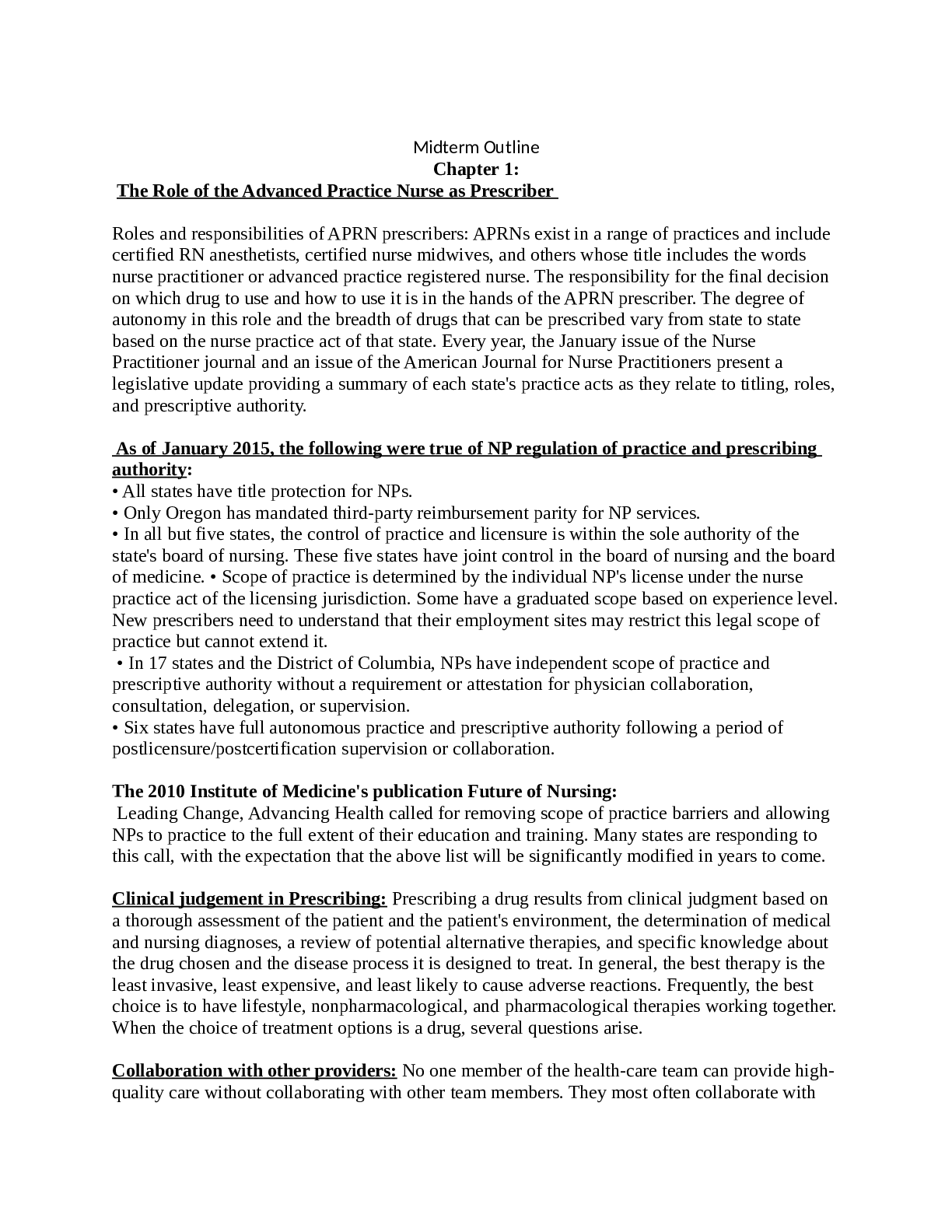Chapter 1:
The Role of the Advanced Practice Nurse as Prescriber
Roles and responsibilities of APRN prescribers: APRNs exist in a range of practices and include
certified RN anesthetists, certified nurse midwives, and others whose title includes the words
nurse practitioner or advanced practice registered nurse. The responsibility for the final decision
on which drug to use and how to use it is in the hands of the APRN prescriber. The degree of
autonomy in this role and the breadth of drugs that can be prescribed vary from state to state
based on the nurse practice act of that state. Every year, the January issue of the Nurse
Practitioner journal and an issue of the American Journal for Nurse Practitioners present a
legislative update providing a summary of each state's practice acts as they relate to titling, roles,
and prescriptive authority.
As of January 2015, the following were true of NP regulation of practice and prescribing
authority:
• All states have title protection for NPs.
• Only Oregon has mandated third-party reimbursement parity for NP services.
• In all but five states, the control of practice and licensure is within the sole authority of the
state's board of nursing. These five states have joint control in the board of nursing and the board
of medicine. • Scope of practice is determined by the individual NP's license under the nurse
practice act of the licensing jurisdiction. Some have a graduated scope based on experience level.
New prescribers need to understand that their employment sites may restrict this legal scope of
practice but cannot extend it.
• In 17 states and the District of Columbia, NPs have independent scope of practice and
prescriptive authority without a requirement or attestation for physician collaboration,
consultation, delegation, or supervision.
• Six states have full autonomous practice and prescriptive authority following a period of
postlicensure/postcertification supervision or collaboration.
The 2010 Institute of Medicine's publication Future of Nursing:
Leading Change, Advancing Health called for removing scope of practice barriers and allowing
NPs to practice to the full extent of their education and training. Many states are responding to
this call, with the expectation that the above list will be significantly modified in years to come.
Clinical judgement in Prescribing: Prescribing a drug results from clinical judgment based on
a thorough assessment of the patient and the patient's environment, the determination of medical
and nursing diagnoses, a review of potential alternative therapies, and specific knowledge about
the drug chosen and the disease process it is designed to treat. In general, the best therapy is the
least invasive, least expensive, and least likely to cause adverse reactions. Frequently, the best
choice is to have lifestyle, nonpharmacological, and pharmacological therapies working together.
When the choice of treatment options is a drug, several questions arise.
Collaboration with other providers: No one member of the health-care team can provide high-
quality care without collaborating with other team members. They most often collaborate with
physicians, pharmacists, podiatrists, mental health specialists, therapists, and other providers,
including APRNs who are not NPs, physician assistants, and other nurses.
Autonomy and Prescriptive authority: The growth in autonomy and prescriptive authority for
NPs and other APRNs is a source of pride. APRNs have now successfully overcome the “cannot
prescribe,” “cannot diagnose and treat,” and “cannot admit” prohibitions to practice that have
required so much time and energy to overturn in the past. More states are broadening and
expanding the legal, reimbursement, and prescriptive authority to practice for all APRNs,
including NPs. By January 2004, all states had recognized the NP title, scope of practice, and
prescriptive authority in legislation. Momentum to full autonomy is gaining, with 26 states
allowing independent practice for NPs and 21 states allowing independent full prescribing as of
January 2015. APRNs in other states have also gained recognition, although the scope of practice
and prescriptive authority is often more restricted. These gains are not written in stone, however,
and can be reversed. Despite continuing research studies that demonstrate the effectiveness of the
role of the APRN in improving patient outcomes, barriers remain. Major concerns related to
prescriptive authority must continue to be addressed. Not all states have legislation that permits
APRNs to prescribe independently of any required physician involvement. Turf battles continue
between APRNs and physicians at national and many state levels over physician supervision
requirements and co-signatures on prescriptions. The advent of the Doctor of Nursing practice
degree with its comparable level of education to that of other health-care providers and a focus
on independent practice may address some of these issues about supervision. However, the
American Medical Association continues to stress the need for physician supervision and final
authority for the patient, even for APRNs who hold the DNP. This push for physician control
occurs despite data from malpractice and malfeasance ratios that clearly show that the rationale
for physician supervision is unfounded.
Read More


